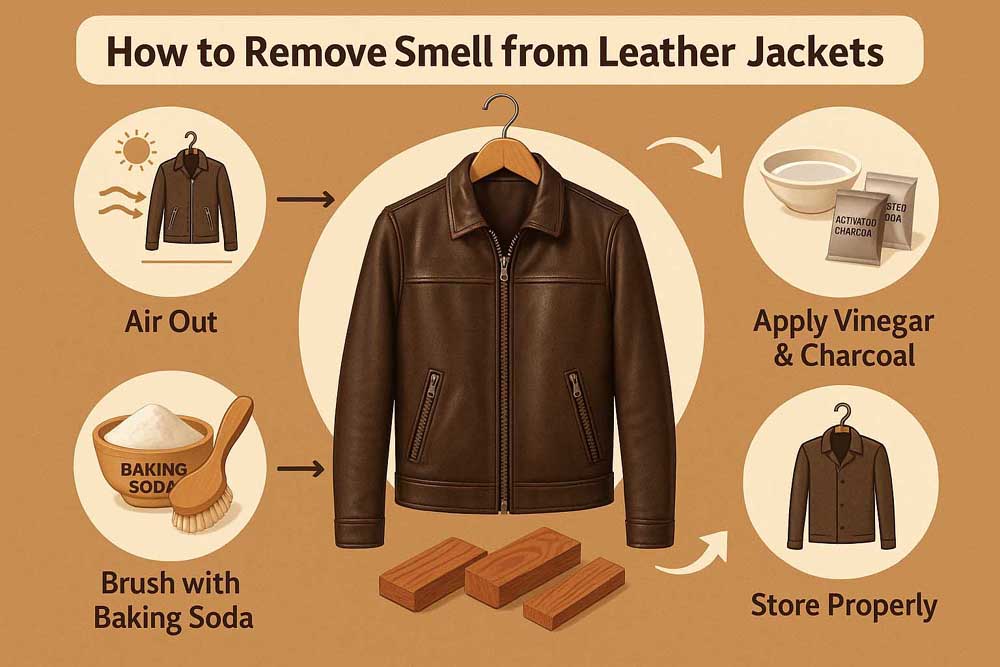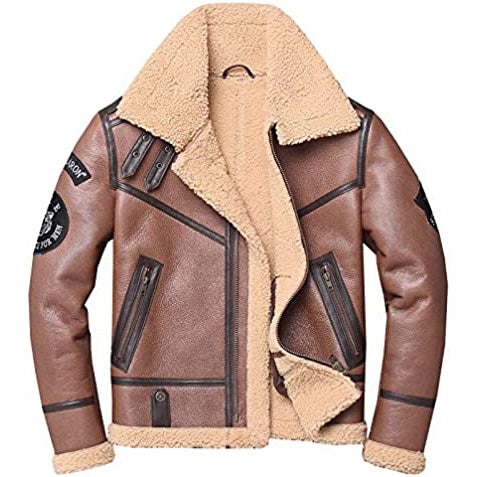Key Takeaways
-
Focus on gentle methods first: airing, baking soda, vinegar
-
Address both leather surface and lining
-
Avoid harsh chemicals or soaking
-
Condition after cleaning to protect leather
-
If smell persists, seek professional help
Introduction
Picture pulling out your favorite leather jacket only to sniff a lingering musty odor. You love its style and feel, but that smell ruins the experience. What if you could restore that crisp, fresh scent without damaging the leather? In this post you’ll learn how to get smell out of a leather jacket using safe, research-backed methods. You’ll get clear, practical steps—from home remedies to expert options—so your jacket can smell as good as it looks again.
Why leather develops odor
Leather is porous and retains moisture, oils, and particles from the environment. Over time, sweat, body oils, smoke, dust, or mold spores penetrate its surface. Tanning agents and finishes used in manufacturing may have residual scents too. If stored improperly—say in plastic bags or damp closets—the smell can intensify. Understanding this helps target the smell removal process.
Identify the type of odor
Not all odors are the same. Knowing what you're dealing with helps:
-
Musty / moldy: often from damp storage
-
Smoke / tobacco: stronger, persistent
-
Body / sweat smell: from prolonged contact
-
Chemical / tanning smell: new or treated leather
If the smell is mold, special care is needed because mold can damage the material. If it's smoke or body odor, milder remedies may work.
Preliminary steps: airing and inspection
First, hang your leather jacket in a well-ventilated area (but avoid direct sunlight). Let it breathe for 1–2 days. Sunlight can fade or dry out the leather, so indirect fresh air is better. Inspect the jacket's interior, seams, and folds. If there is visible mold, lightly wipe with a cloth before applying any deodorizing method, so you’re not sealing in the issue.
Using baking soda or baking powder
One of the safest odor absorbers. Sprinkle a generous layer inside and outside the jacket (especially in folds). Let sit for 12–24 hours. The powder will absorb moisture and odor compounds. Then gently brush or vacuum off the powder. This method works well for mild smells. Do it in a dry environment so baking soda doesn’t cake or stain.
The white vinegar method
Mix equal parts white vinegar and distilled water in a spray bottle. Lightly mist the jacket (don’t saturate). Wipe with a soft microfiber cloth. The acidity helps neutralize odor-causing bacteria. Let the jacket air dry. Always patch-test on an inconspicuous area to ensure it does not affect the color.
Activated charcoal and odor absorbers
Put activated charcoal in a breathable bag (cloth or mesh), and place it inside or near the jacket for a couple of days. Charcoal is highly efficient at absorbing VOCs and lingering smell. Also, silica gel packs or odor absorber pouches (for shoes) can help.
Coffee grounds or newspaper traps
Fill a breathable sachet with dry coffee grounds and place inside the jacket. Coffee’s aroma helps mask odor temporarily while absorbing smell. Alternatively, wrap the jacket (or key parts) in newspaper for 24–48 hours. Newspaper can pull out some odors.
Gentle leather cleaning
Use a leather cleaner specifically formulated for garments (pH-balanced, no harsh solvents). Apply a small amount on a soft cloth and work in circular motions. Avoid over-wetting. After cleaning, wipe off residue. Cleaning may remove grime or residual substances that trap odors.
Using enzyme or odor eliminator sprays
Some commercial sprays are made for leather and include enzymes that break down odor molecules (especially for organic smells). Use lightly on the lining and inside surfaces. Test on a hidden spot first. Avoid aerosol sprays that may leave residues.
Deodorizing the lining separately
Often the liner (fabric inside) is the real culprit. If it's removable, wash it according to care labels and air dry. If not removable, lightly mist a fabric-safe deodorizer or enzyme cleaner inside, then air thoroughly. This approach addresses odors that linger in fabric rather than leather.
Conditioning and restoring natural oils
After cleaning and deodorizing, apply a quality leather conditioner to replenish oils, maintain suppleness, and help seal the surface. Use a soft cloth and a thin layer. This also helps reduce likelihood of future absorption of odors.
When to consider professional leather cleaning
If persistent odor remains (especially smoke or deep mold), take the jacket to a reputable leather cleaner. They have specialized solvents, ozone chambers, or steam techniques beyond home remedies. Be aware: even professionals may not fully remove some smells.
Preventive storage and care practices
To avoid odor recurrence:
-
Store leather in breathable garment bags (avoid plastic)
-
Use padded hangers to preserve shape
-
Keep away from damp or humid places
-
Air jackets occasionally
-
Avoid exposure to smoke, perfumes, chemicals
-
Deep clean and condition seasonally
Expert opinion
According to leather restoration professionals, many DIY “miracle” home remedies (ammonia, heavy sprays, soaking) fail or damage leather. A balanced approach—gentle deodorizing paired with proper cleaning and conditioning—is the most reliable. Also, Derek Guy tested air, vodka, leather cleaner, and coffee bean methods; only some had moderate success depending on jacket age and smell intensity.
Frequently Asked Questions
Q1: Will machine washing remove smell from a leather jacket?
No. Leather should never be machine washed. Water and agitation can damage the structure, strip oils, shrink, or warp the jacket.
Q2: Can sunlight alone remove smoke smell?
Sunlight may help reduce odor via UV, but overexposure can fade or dry the leather. Use indirect light and short durations only.
Q3: Is vodka really effective?
Some users spray diluted vodka to neutralize odors, but it’s risky. Vodka is alcohol and may dry out or dull the finish. Use only minimally and patch-test first.
Q4: What if the smell returns?
It may indicate ongoing moisture, mold, or poor storage. Repeated airing, use of charcoal absorbers, and better storage can help.
Q5: How often should I deodorize or clean?
Do light maintenance (air out, wipe) monthly, deeper cleaning and conditioning every 3–6 months, or before seasonal storage.
Don’t let odor ruin your leather. Try the safer home methods above, and if your jacket still smells, bring it to Jackets Kingdom’s leather care service for expert cleaning. Enjoy your jacket fresh again—ready to wear with confidence.





